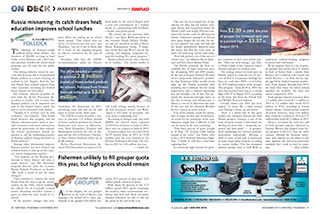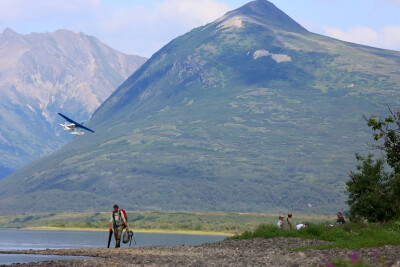Alaska & Pacific
Russia misnaming its catch draws heat;
education improves school lunches
By Charlie Ess
The labeling of Russian-caught pollock being from Alaska, the donation of 450,000 servings to food banks across America and a $3.9 million purchase of fillets for school lunch programs sets the tone for the public market. The fishing industry voiced its concerns that Russian fish is being labeled Alaska pollock at a senate hearing on seafood in late August. And the fact that Russia bans seafood imports from other countries, including the United States, doesn’t set well either.
“Simply, U.S. seafood can’t be sold in Russia,” says Gilmore. “You would think between that inequity and the Obama administration’s push to provide consumers with more information about the provenance of their seafood, the federal government would act quickly to end the misleading practice of Russian pollock being identified as Alaska pollock.” Among other detrimental impacts, Russian product has been thawed and refrozen before it ends up in this country, which compromises quality. “The majority of that Russian production is twice frozen and ours is single frozen,” says Pat Shanahan, program director with the Genuine Alaska Pollock Producers in Seattle. “We made a report to get the name changed.” Their petition to remove the word Alaska from the label is up for consideration by the FDA, which publishes the official list of acceptable seafood names. Shanahan wouldn’t venture a guess on when the issue would be resolved.
As for positive changes this year, more fillets are ending up on school lunch menus. “Our school sales are up by 14.3 percent over last year,” says Shanahan, “and we’d like to think that it’s a result of our ongoing program to educate consumers for the past 10 years.” Shanahan adds that the USDA’s recommendation under its Dietary Guidelines for Americans in 2011, specifying more fish and less fat and sugar in school meals, didn’t hurt.
The USDA recently awarded a contract to purchase 2.8 million pounds of frozen pollock products for schools. Shipments will arrive in Massachusetts, New Hampshire, Virginia and Washington between the end of August and the end of February. Purchases from Trident Seafoods tallied up to $3.88 million. At-Sea Processors Association donated 450,000 pollock servings to U.S. food banks by the end of August with a year-end commitment of 1 million meals, in a partnership with SeaShare, a Seattle non-profit group.
“We donate the raw material, fillet blocks,” says Marc Wells, president of the Genuine Alaska Pollock Producers and vice president of sales at Arctic Storm Management Group. “Companies on the East and West Coast do the cutting, and shipping companies donate the hauling. It’s a great program.”
Alaska pollock surimi sales continue to be healthy. “The surimi market is still really strong, mainly because of the lack of tropical surimi,” says Wells. “Japan is still short of inventory, and even India is importing now. ” According to foreign trade data with NMFS, the United States exported 23,400 kilos of surimi to India in 2014; there were no exports to India in 2013. Exports to Japan have increased from 56.29 million kilos in 2013 to 71.88 million kilos last year. Exports to the Russian Federation fell from 3.56 million in 2013 to 2.46 million last year.
* * *
Gulf/So. Atlantic
Fishermen unlikely to fill grouper quota this year, but high prices should remain
By Hoyt Childers
As of late August, the red grouper harvest in the Gulf of Mexico was running a bit behind 2014, when participants in the grouper IFQ fishery harvested 99.5 percent of that year’s 5.63 million pound commercial quota. With about 46 percent of the 5.72 million pound 2015 quota remaining, the weather, other environmental conditions and luck will likely determine whether fishermen are able to fish out the quota by the end of the year. This year has been largely free of significant red tides, but the massive toxic algae bloom that meandered down the Florida Gulf Coast in July 2014 and continued for weeks could be affecting the fishery. Fishermen managed to harvest their quota despite the red tide, but observers reported very large fish kills and the bloom undoubtedly displaced some fish stocks that fled the toxic zone, at times 100 miles long and 60 miles wide.
“Red tide pushed a lot of fish out of a certain area,” says Madeira Beach fisherman and fleet owner Martin Fisher.
The Florida peninsula has been remarkably free of major hurricanes since the devastating 2004 and 2005 seasons. At the end of August, National Weather Service projections indicated a possibility that Hurricane Erika would sweep right up the Florida peninsula after pounding the Caribbean, but the storm degenerated into a tropical depression that just brought a lot of rain. The potential for hurricane-wrought harm to life, the economy and infrastructure is always a concern to fishermen this time of the year and the National Weather Service expects an active season.
Even if the industry avoids the disruption of major weather and environmental events for the remainder of the year, fishermen might find it difficult to fish out the quota in the time remaining.
“Fifty-three percent of quota [caught as of Aug. 27], leaving 2.668 million pounds in the water,” says Fisher, who is also a 2014 National Fisherman Highliner. “I think we will have a hard time capturing that.”
A consistently high demand for grouper continues to fuel a very robust market. “Price has been strong,” says Fisher. There is little, if any, reason to expect demand and price to weaken soon.
The average annual ex-vessel price in Florida, which accounts for over 97 percent of all U.S. red grouper landings, has been on a roll since 2009, a year before the 2010 implementation of the grouper IFQ program. From $2.39 in 2009, the price has increased each year to a current high of $3.37 in August 2015, according to the latest data from the Florida Fish and Wildlife Research Institute.
Overall, Fisher says 2015 has been typical. “It seems like a fairly normal year. Fishing is always up and down.”
There is a down side to the great market and consumer demand for fresh Florida grouper. Grouper is one of the most frequent victims of fish fraud, the labeling of a lesser fish — frequently imported and farm-raised — as grouper. Such mislabeling has reached epidemic proportions nationwide, affecting a third or more of fish sold in restaurants in many major urban markets, according to various studies. This has prompted industry groups, such as Gulf Wild, to implement seafood-tracking programs to protect the Gulf brand.
As for imports, there is a lot of genuine grouper that reaches the U.S. market in fresh or frozen form —mostly from Mexico, the Caribbean and Central and South America — to flesh out the supply gap left by limited domestic production. From January through June 2015, the latest time frame for which federal numbers are available, the story was mixed compared to 2014. Fresh grouper imports increased, from 1.9 million kilos worth $17.1 million in 2014 to 2.2 million kilos worth $19.9 million in 2015, according to federal import statistics. Frozen grouper imports decreased, however, from 0.44 million kilos worth $2.3 million in 2014 to 0.37 million kilos worth $2.2 million in 2015.
Mexico accounted for well over half of fresh grouper imports, followed by Panama. Mexico also shipped more frozen grouper to the U.S. than any other country. Irksome for domestic fishermen, such imports are not subject to the same rigorous size and stock protection standards they work so hard to maintain.








